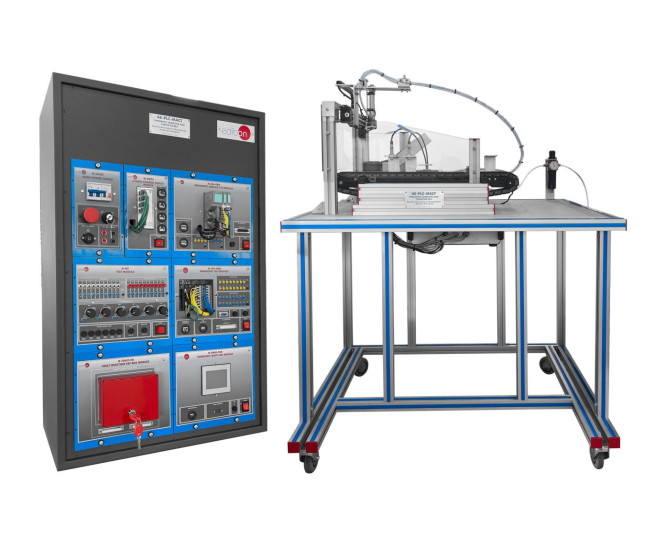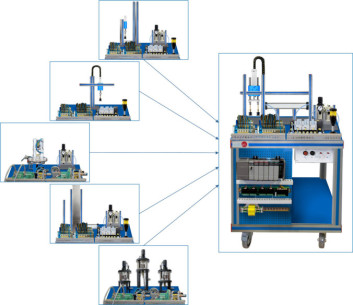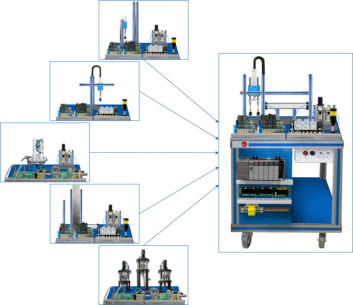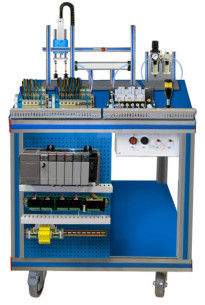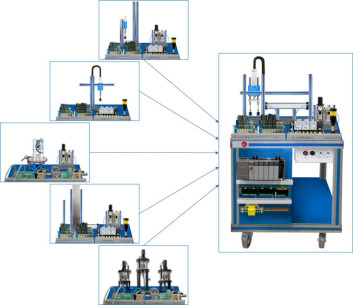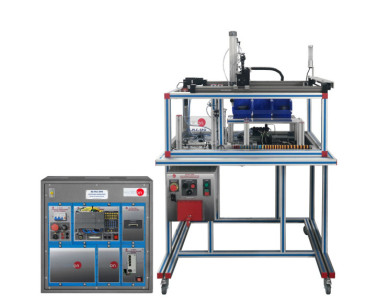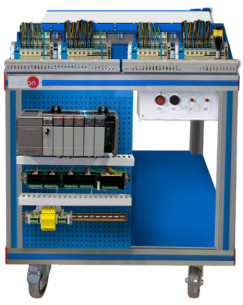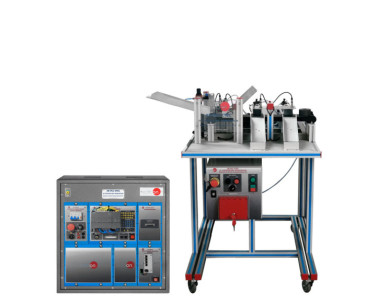At EDIBON, we are committed to strengthening skills as a strategic pillar for the competitiveness and social well-being of the European Union. Proper training not only boosts the economy but also enables individuals to fully participate in society and democracy.
AE-PLC-MACT 공압식 조작 교육용 스테이션 및 컨베이어 벨트
혁신적인 시스템
The Pneumatic Handling and Conveyor Belt Workstation, "AE-PLC-MACT", has been designed by EDIBON to let students getting familiar with automatic systems with conveyor systems, including PLC, industrial sensors, and pneumatic actuators.
관련 뉴스
일반적인 설명
The Pneumatic Handling and Conveyor Belt, "AE-PLC-MACT", is an automatic handling station with a conveyor system commanded by a PLC. The "AE-PLC-MACT" is composed of a pneumatic handling system that uses vacuum technology to move pieces from the input area to the conveyor system or vice versa.
The "AE-PLC-MACT" pneumatic station consists of:
- DC conveyor belt with servomotor, which allows to control the speed, position and direction of rotation.
- Part sensors to detect the part and stop the belt to place another part.
- Pneumatic system for moving parts using vacuum technology to pick them up.
- PLC that automates the process.
- Removable key switch to turn the equipment on or off.
- Control panel with mushroom type stop switch, stop start buttons, manual and automatic mode, indicator lights.
연습 및 가이드
매뉴얼에 포함 된 가이드 실기 연습
- Introduction to Flexible Manufacturing System (FMS).
- Introduction to pneumatics and electro-pneumatics.
- Configuration of a pneumatic application.
- Introduction to vacuum technology.
- Study of the sensor detection.
- Manual control of a handling system.
- Automatic control of a handling system.
- Modification of the parameters of the handling process.
- Study and analysis of the faults inserted in the process with the fault generation module.
장비로 수행 할 수있는 더 많은 실용적 연습
- Optimization of process time.
비슷한 제품
6.2.5.4.- 부품 처리 워크 스테이션 애플리케이션
AE-PLC-MAE
The "AE-PLC-MAE" is an electrical handling system commanded by a PLC. The "AE-PLC-MAE" is composed of a two axis electrical manipulator with a pneumatic gripper to transport the pieces from the input pieces holder to the corresponding position,...
6.2.5.4.- 부품 처리 워크 스테이션 애플리케이션
AE-PLC-MAN
공압식 조작 교육용 스테이션
The "AE-PLC-MAN" is a pneumatic handling workstation commanded by a PLC, which performs handling and sorting functions.The workstation identify the color of the input pieces at the input pieces area, once the color is identified, the station take...
6.2.5.4.- 부품 처리 워크 스테이션 애플리케이션
AE-PLC-MPS
부품 처리 교육용 스테이션
The "AE-PLC-MPS", Pieces Manipulator Workstation, is a unit that works with pneumatics, electro-pneumatics and vacuum technologies.The "AE-PLC-MPS" performs the following operation: moving a piece from one position to another by using suction pads...
6.2.5.4.- 부품 처리 워크 스테이션 애플리케이션
AE-PLC-T
직선 이송 교육용 스테이션
The "AE-PLC-T" is a linear transporting system, which moves the pallets, that carries the pieces, along the system. The unit is configured in a closed loop conveyor powered by an electrical motor, the whole system is commanded by a PLC. The...
6.2.5.4.- 부품 처리 워크 스테이션 애플리케이션
AE-PLC-SPO
위치 결정 교육용 스테이션
The Positioning Workstation, "AE-PLC-SPO", has been designed by EDIBON to studiy three-axis positioners for computer integrated manufacturing systems. It sorts incoming pieces based on material and dimensions using a PLC-controlled manipulator.The...
6.2.5.4.- 부품 처리 워크 스테이션 애플리케이션
AE-PLC-CTCA
AC 컨베이어 벨트 교육용 스테이션
The "AE-PLC-CTCA" is an AC powered conveyor system commanded by a PLC. The "AE-PLC-CTCA" is composed by a conveyor, 4 position sensors to stop the conveyor at different positions, motor positioner, AC motor driver and three-phased motor to a...
6.2.5.4.- 부품 처리 워크 스테이션 애플리케이션
AE-PLC-CTCC
DC 컨베이어 벨트 교육용 스테이션
The DC Conveyor Belt Workstation, "AE-PLC-CTCC", explores DC conveyor system management, including piece classification. It features industrial components like PLC, sensors, etc., enabling control of an automatic DC-powered conveyor system with...
보완 장비
6.2.5.4.- 부품 처리 워크 스테이션 애플리케이션
AE-PLC-MPS
부품 처리 교육용 스테이션
The "AE-PLC-MPS", Pieces Manipulator Workstation, is a unit that works with pneumatics, electro-pneumatics and vacuum technologies.The "AE-PLC-MPS" performs the following operation: moving a piece from one position to another by using suction pads...
6.2.5.4.- 부품 처리 워크 스테이션 애플리케이션
AE-PLC-T
직선 이송 교육용 스테이션
The "AE-PLC-T" is a linear transporting system, which moves the pallets, that carries the pieces, along the system. The unit is configured in a closed loop conveyor powered by an electrical motor, the whole system is commanded by a PLC. The...
6.2.5.4.- 부품 처리 워크 스테이션 애플리케이션
AE-PLC-SPO
위치 결정 교육용 스테이션
The Positioning Workstation, "AE-PLC-SPO", has been designed by EDIBON to studiy three-axis positioners for computer integrated manufacturing systems. It sorts incoming pieces based on material and dimensions using a PLC-controlled manipulator.The...
6.2.5.4.- 부품 처리 워크 스테이션 애플리케이션
AE-PLC-MAE
전기식 조작 교육용 스테이션
The "AE-PLC-MAE" is an electrical handling system commanded by a PLC. The "AE-PLC-MAE" is composed of a two axis electrical manipulator with a pneumatic gripper to transport the pieces from the input pieces holder to the corresponding position,...
6.2.5.4.- 부품 처리 워크 스테이션 애플리케이션
AE-PLC-MAN
공압식 조작 교육용 스테이션
The "AE-PLC-MAN" is a pneumatic handling workstation commanded by a PLC, which performs handling and sorting functions.The workstation identify the color of the input pieces at the input pieces area, once the color is identified, the station take...
6.2.5.4.- 부품 처리 워크 스테이션 애플리케이션
AE-PLC-CTCA
AC 컨베이어 벨트 교육용 스테이션
The "AE-PLC-CTCA" is an AC powered conveyor system commanded by a PLC. The "AE-PLC-CTCA" is composed by a conveyor, 4 position sensors to stop the conveyor at different positions, motor positioner, AC motor driver and three-phased motor to a...
6.2.5.4.- 부품 처리 워크 스테이션 애플리케이션
AE-PLC-CTCC
DC 컨베이어 벨트 교육용 스테이션
The DC Conveyor Belt Workstation, "AE-PLC-CTCC", explores DC conveyor system management, including piece classification. It features industrial components like PLC, sensors, etc., enabling control of an automatic DC-powered conveyor system with...
품질

판매 후 서비스

 쿠키 기본 설정
쿠키 기본 설정

